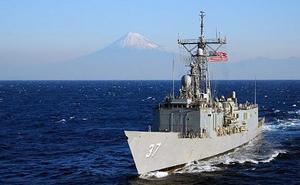In the trenchesUnmanned ships to track hostile subs
A U.S. military plan to build a crewless, automated robo-frigate which could trail hostile submarines across the oceans for months without supervision; the need for such a system arises because the next-generation air independent propulsion (AIP) submarine technology is spreading beyond Western-aligned nations; these subs could run submerged for thousands of miles

Picture this vessel on patrol with no crew // Source: popsci.com
A U.S. military plan to build a crewless, automated robo-frigate which could trail hostile submarines across the oceans for months without supervision — the ACTUV project — is moving forward, with several contracts recently announced.
Back in February Lewis Page wrote about the ACTUV (Anti-submarine warfare Continuous Trail Unmanned Vessel) scheme when it was announced. The idea was to nullify the menace of cheap, very silent diesel-electric submarines — considered a serious problem by many in the major Western navies.
When such a submarine is located — for instance, it might be spotted leaving harbor and then submerging — an ACTUV vessel would be tasked to follow it. A next-generation air independent propulsion (AIP) submarine of the sort now perhaps at last beginning to spread beyond Western-aligned nations could run submerged for thousands of miles, albeit slowly. Following it using ordinary manned frigates or submarines would tie up a lot of people and equipment. The shadowing vessels would need to try and hold the quiet sub on sonar while staying outside the range of its weapons, a challenging task even with the latest low-frequency active sonars and one which would probably involve a lot of use of aircraft.
An unmanned ACTUV, however, with no need to fear about being torpedoed, could sit right on top of the sub and track it easily. Being on the surface and thus able to run diesels and gas-turbines, it would have no trouble keeping up with the battery or AIP powered sub. Being unmanned would mean the ACTUV could be designed for the best possible performance and seakeeping, rather than for the convenience of its crew.
Lewis Page notes that probably the only part of the ACTUV that would normally be above the waves would be a combination funnel/engine intake and communications/sensors mast.
If the submarine captain, tiring of being shadowed, should torpedo his follower he would create what is known as a “flaming datum” — his position would then be marked for all to see by the burning wreck of the robo-frigate and he would need to flee the scene of the crime. A diesel/AIP sub going at any speed submerged, however, will run its batteries flat very fast — so leaving itself pinned to the map not far from the flaming datum, easy target for responding ships or aircraft.
One major issue for the ACTUV would be the need for it to avoid crashing into other ships while trailing its unseen submerged quarry across thousands of miles of ocean, a task normally carried out by human watch-keeping officers who make course alterations in accordance with the International Regulations for Prevention of Collisions at Sea.
Instead, the ACTUV will use an “artificial intelligence engine” originally developed for use in NASA’s Mars rovers. Page writes that other Phase 1 study contracts have been handed out to the north American arm of QinetiQ, and to sonar-analysis-cum-games-developer-and-audio-studio firm Sonalysts — perhaps most famous for producing submarine-warfare games such as 688 Hunter/Killer and Fleet Command.
Perhaps our readers have already guessed this: the ACTUV project is a brainchild of DARPA, the Defense Advanced Research Projects Agency.
